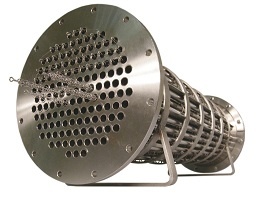Introduction :
Coil Gavin Heat Exchangers are constructed using circular layers of helically corrugated tubes placed inside a light compact shell. The fluid in each layer flows in the opposite direction to the layer surrounding it, producing a criss-cross pattern. The large number of closely packed tubes creates a significant heat transfer surface within a light compact shell. The alternate layers create a swift uniform heating of fluids increasing the total heat transfer coefficient. The corrugated tubes produce a turbulent flow where the desired feature of fluctuating velocities is achieved. This haphazard movement of fluid particles reduces deposit build up by performing a “scoop and lift” action. The connection locations and angle of entry is specially selected to reduce the probability of debris build-up.
Process Of Coil Gavin Heat Exchangers:
Coil Gavin heat exchangers are beverage cooler 40 comprises a tank or bath 52containing a liquid sub-zero coolant, and a heat exchanger 46 inside the tank which in use forms a bank of frozen, sub-zero coolant on the Coil Gavin heat exchanger. A beverage coil 54, in the form of a python, is immersed in the liquid coolant for routing and chilling a beverage. The liquid coolant also provides a reservoir for a coolant circuit 66,67 to a font to provide an ice tower. A divert valve is provided which can be controlled to divert hot refrigerant directly through the evaporator in the tank, to actively heat the bath so that a cleaning solution passed through the beverage coil does not freeze. By avoiding a passive defrost one can thereby speed up the cleaning cycle. In use, the beverage cooler chills a beverage and a font with a single tank rather than the conventional twin tanks.
Images Of Coil Gavin Heat Exchangers:

Advantages Of Coil Gavin Heat Exchangers:
- High Performance: the unique coil arrangement has a large heat transfer area meaning high heat transfer coefficients.
- Compact and Lightweight: A closely packed tube makes our shell and coil exchangers compact and lightweight. Small footprint makes it easy to install where space is limited and hard to access.
- Low Maintenance Costs: corrugated tube design produces a high turbulent flow, which reduces deposit build-up and fouling. This means longer operating cycles between scheduled cleaning intervals.
- Low Installation Costs: vertical installation makes it ideal for hydric heating and cooling systems where space is an issue.
- Higher Temperature Differentials: helical design allows for higher temperatures and extreme temperature differentials without high stress levels and costly expansion joints.
- Flexible Designs: variety of model types and configurations allow shell and coil heat exchangers to be used with a wide range of pressures, temperatures, and flows.
- Low Pressure Drop:
- Easy selection based on sub-station space requirements and heat or cooling load.
- Units kept in stock for immediate delivery.
Applications Of Coil Gavin Heat Exchangers:
- Construction-the building roof plate, roof grille etc.
- Light industry-the home appliances with its shell, civil chimneys, kitchen appliances etc.
- Automobile-corrosion resistant parts of car etc.
- Farming livestock and fishing-food storage tools; frozen processing equipment of meat and aquatic products etc.
- Commerce-storage and transportation of materials, packaging equipment.

